Common Name(s): Coolibah, coolabah
Scientific Name: Eucalyptus coolabah (E. microtheca and a number of less-common species are also considered coolibahs, see comments below)
Distribution: Eastern Australia
Tree Size: 20-30 ft (6-10 m) tall,
1-2 ft (.3-.6 m) trunk diameter
Average Dried Weight: 70.6 lbs/ft3 (1,130 kg/m3)
Specific Gravity (Basic, 12% MC): .98, 1.13
Janka Hardness: 3,730 lbf (16,590 N)
Modulus of Rupture: 20,960 lbf/in2 (144.5 MPa)
Elastic Modulus: 2,500,000 lbf/in2 (17.24 GPa)
Crushing Strength: 11,800 lbf/in2 (81.3 MPa)
Shrinkage: Radial: ~3%, Tangential: ~6%,
Volumetric: ~9%, T/R Ratio: ~2
Color/Appearance: Heartwood ranges from orangish pink to a much darker reddish brown. Thin sapwood is grayish white. Nearly always seen in burl form. Less-common coolibah species have darker grayish brown to nearly black heartwood (see comments below).
Grain/Texture: Grain is generally interlocked, with a fine texture.
Rot Resistance: No official test data available, but the heartwood is anecdotally reported to be both very durable and termite resistant.
Workability: Coolibah species are among the very hardest eucalypts in Australia, and yield some of the hardest wood in the world. Coolibah also has interlocked grain, making it rather difficult to work in most operations, with tearout and blunting of cutting edges common.
Odor: No characteristic odor.
Allergies/Toxicity: Although severe reactions are quite uncommon, coolibah has been reported to cause skin irritation. See the articles Wood Allergies and Toxicity and Wood Dust Safety for more information.
Pricing/Availability: Almost without exception exported as burl caps or burl wood blanks. Prices are very high, on par with most other imported Australian burls. Solid unfigured wood may be available domestically on a limited basis, though because of the gnarly and highly branching growth form, pieces are likely to be rather short.
Sustainability: Coolibah is not listed in the CITES Appendices, but is reported by the IUCN as being near threatened (for E. coolabah only). Technically it doesn’t meet the Red List criteria of a vulnerable or endangered species, but is close to qualifying and/or may qualify in the near future.
Common Uses: Turned objects, knife and gun grips, inlay, and other small specialty items. Non-burl wood has also been compared to lignum vitae (Guaiacum spp.) as a substitute in hard-wearing applications such as bearings and pulleys.[1]Niesigh, J. W., & Watson, C. J. B. (1923). Coolibah (E. Microtheca). The Australian Forestry Journal, 6-7, 294-295.
Comments: The name coolibah comes from the name gulabaa given to the tree by indigenous Australians. The coolibah trees known today encompass several different species, but when it was first described in 1858, it was recognized as a single species: Eucalyptus microtheca. (The Eucalyptus genus has over 700 recognized species, and botanists have divided and subdivided this large pie into progressively smaller slices—to the point where most authors describe coolibah species in a hierarchy four to five layers deep under Eucalyptus.) Most authors agree that coolibah species are a sub-group of Australian box trees, and the two groups are closely related.[2]Hill, K. D. (1994). Symphyomyrtus section Adnataria series Oliganthae subseries Microthecosae. TELOPEA, 5(4), 743-771.
Currently, the Centre for Australian National Biodiversity Research (CANBR) and their internet-based EUCLID project is perhaps the most authoritative and up-to-date resource for eucalypts. The authors here currently recognize four discernible coolibah species, though mention is also given to other species in this specialized grouping, totaling ten species.[3]Brooker, M. I. H. (2000). A new classification of the genus Eucalyptus L’Her.(Myrtaceae). Australian systematic botany, 13(1), 79-148.
The four primary species listed by EUCLID:
- Eucalyptus coolabah | inland coolibah On a practical level for woodworkers and turners, this is likely the most commonly seen commercial species. It is very dense and has a rich red heartwood (including burls) that most woodworkers associate with the name coolibah. All the mechanical data and written descriptions above are for this species.
- Eucalyptus microtheca | northern coolibah Although this was the original species described, the name has now been narrowed to include a more particular definition of trees, primarily occurring in northern Australia. Unfortunately, older writings usually used the E. microtheca name in the broader sense and descriptions may actually refer to what is considered E. coolabah today. Nonetheless, trees from this narrower species definition produces heartwood that tends to be a darker grayish brown, sometimes with an olive cast. It also contains whitish mineral deposits in the pores that can be seen as “threads” even on the facegrain of the wood. These differences are believed to be caused by different climates and growing conditions of the trees.[4]Dimitriadis, E. (2019). Distinguishing Coolibah Trees and their Woods. World of Wood, 72(2), 21–22.
- Eucalyptus acroleuca | Lakefield coolibah This is a less-common species of coolibah, restricted to the Lakefield National Park area in Queensland, Australia. Since this is a protected area, it’s highly unlikely to see much of this wood commercially. However, this species yields wood that is very dark brown to nearly black, with an approximate average dried weight around 84.3 lbs/ft3 (1,350 kg/m3)![5]Dimitriadis, E. (2019). Distinguishing Coolibah Trees and their Woods. World of Wood, 72(2), 26.
- Eucalyptus victrix | smooth-barked coolibah This is a more recently described species, being recognized in 1994 on the basis of its characteristic smooth, white bark throughout the tree.[6]Hill, K. D. (1994). Symphyomyrtus section Adnataria series Oliganthae subseries Microthecosae. TELOPEA, 5(4), 743-771. This species isn’t very common in woodworking applications, and the wood tends to be slightly lighter at around 65.5 lbs/ft3 (1,050 kg/m3).[7]Dimitriadis, E. (2019). Distinguishing Coolibah Trees and their Woods. World of Wood, 72(2), 25.
There are also six remaining species also botanically classified in the same sub-grouping:
(Eucalyptus > Symphyomyrtus > Adnataria > Apicales > Aquilonares > Protrusae)
- Eucalyptus argillacea | Mount House box
- Eucalyptus chlorophylla | green-leaf box
- Eucalyptus distans | Katherine box
- Eucalyptus microneura | Gilbert River box
- Eucalyptus obconica | obconica box
- Eucalyptus tectifica | Darwin box
There are other closely-related box species that technically don’t fall into the same botanical sub-group but sometimes bear the name coolibah:
- Eucalyptus orgadophila | mountain coolibah Average dried weight 76.8 lbs/ft3 (1,230 kg/m3).
- Eucalyptus intertexta | inland red box Sometimes called bastard coolibah; average dried weight of 68.7 lbs/ft3 (1,100 kg/m3).
Images: Drag the slider up/down to toggle between raw and finished wood.
Identification: See the article on Hardwood Anatomy for definitions of endgrain features.
Porosity: diffuse porous
Arrangement: exclusively solitary pores, sometimes occurring in diagonal/radial patterns
Vessels: medium to large, few to moderately numerous; tyloses and mineral deposits common
Parenchyma: diffuse-in-aggregates, and weakly vasicentric (diffuse parenchyma is generally very sparse and barely visible)
Rays: narrow to medium width; normal spacing
Lookalikes/Substitutes: Coolibah can be confused with other dense, reddish brown species of Eucalyptus, especially river red gum (E. camaldulensis), also occurring in eastern Australia. Jarrah (E. marginata) is another species that can have a similar appearance, but is conversely found in western Australia, so mixups are less common.
Notes: Within the species designated as coolibah, E. coolabah tends to have reddish brown heartwood and lacks contrasting mineral deposits in the pores, while the heartwood of E. microtheca tends to have more of a grayish olive cast, as well as white-colored mineral deposits in many of the pores, visible in the raw wood even on the facegrain.
The following is an alphabetical listing of all Eucalyptus species. For an more in-depth look at the various coolibah and closely-related box species, refer to the comments above.
Related Content:
References[+]
| ↑1 | Niesigh, J. W., & Watson, C. J. B. (1923). Coolibah (E. Microtheca). The Australian Forestry Journal, 6-7, 294-295. |
|---|---|
| ↑2, ↑6 | Hill, K. D. (1994). Symphyomyrtus section Adnataria series Oliganthae subseries Microthecosae. TELOPEA, 5(4), 743-771. |
| ↑3 | Brooker, M. I. H. (2000). A new classification of the genus Eucalyptus L’Her.(Myrtaceae). Australian systematic botany, 13(1), 79-148. |
| ↑4 | Dimitriadis, E. (2019). Distinguishing Coolibah Trees and their Woods. World of Wood, 72(2), 21–22. |
| ↑5 | Dimitriadis, E. (2019). Distinguishing Coolibah Trees and their Woods. World of Wood, 72(2), 26. |
| ↑7 | Dimitriadis, E. (2019). Distinguishing Coolibah Trees and their Woods. World of Wood, 72(2), 25. |

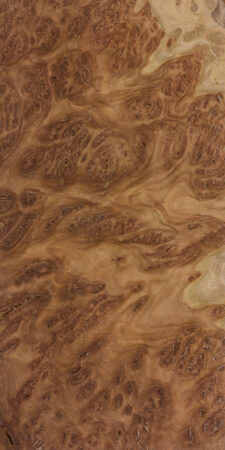
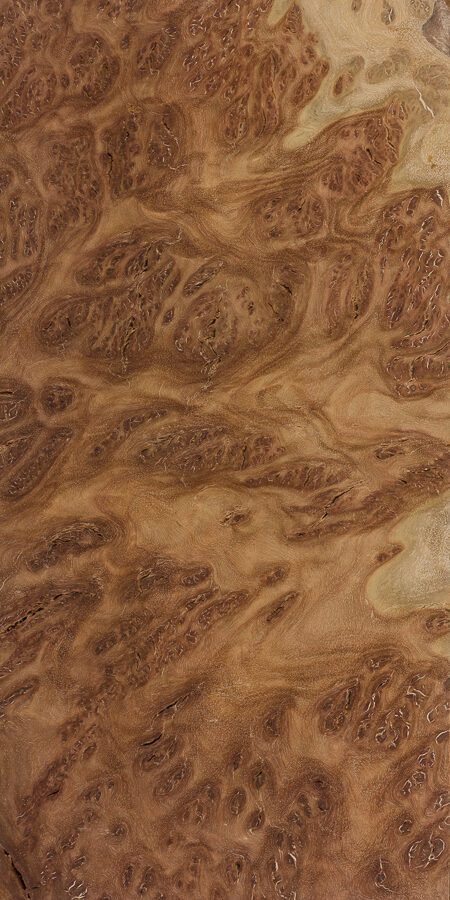
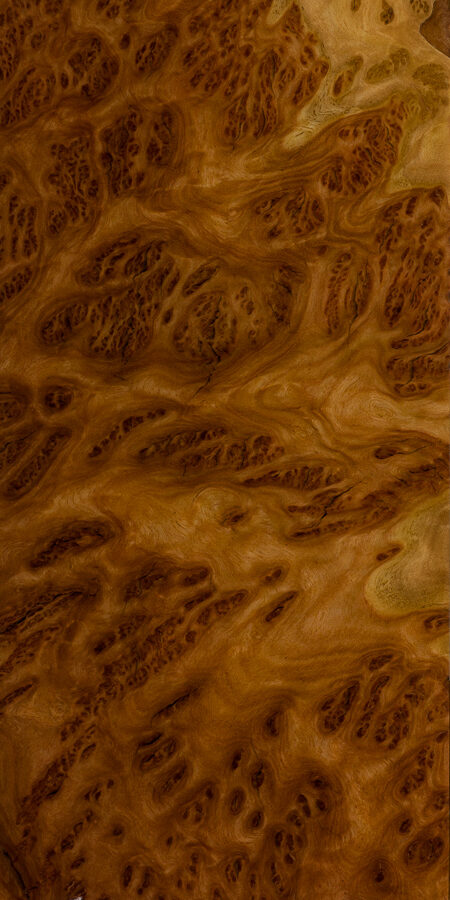
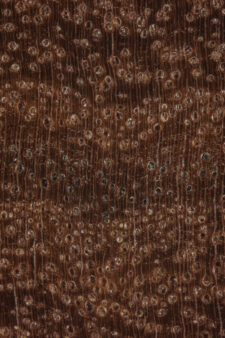

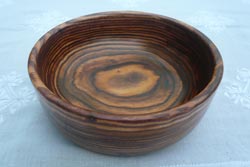






A turned platter from Coolabah
That’s beautiful!